|
|
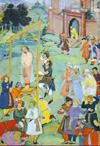 |
==Mansur
al-Hallaj passes through Sind (c.905): The great Sufi (*Univ.
of Georgia*) saint Mansur ul-Hallaj makes a missionary journey to
Sind
in about 905. Although he composes a number of mystical writings (*Univ.
of Georgia*), he is far more widely known for his martyrdom in
Baghdad
in 922.
Intoxicated with the Divine presence, he is finally executed when he
refuses
to stop publicly proclaiming "Ana'l-Haq" (I am God/Truth). In Sindhi
and
Punjabi mystical folk poetry he is the supreme example of ecstatic love
of God. |
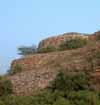 |
==Delhi
emerges (c.900–1000): "The first of the seven historical
cities of Delhi is founded by Tomara Rajputs, who establish themselves
as preeminent among competing regional powers in the northern plains
after
gaining independence from Gurjara-Pratihara control earlier in the
century.
The Tomaras build a fort (Lal Kot), later expanded and called Qila Rai
Pithaura, the fort of Prithvi Raj Chauhan" (--Met); *wiki*.
|
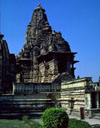 |
==Khajuraho
is begun (c.900–1000): "The Chandellas, gaining power as
the Gurjara-Pratihara dynasty wanes, patronize the construction of
ornate
temples in the nagara, or northern, style at their capital Khajuraho in
Madhya Pradresh. More than eighty temples, built around a lake, are
noted
for their tall spires and exceptionally fine sculptures" (--Met).
Image sets: *DSAL*;
*AIIS
Penn.*; *Berger*.
Discussion: *art
and archaeology*; *India
Nest*. [*Routes*] |
 |
==Subuktigin
rules in Ghazni (c.977-97): Alptigin, a Turkic slave
given
military training by the Samanid dynasty of eastern Iran, is dismissed
from his post as regional governor in 961. He makes a dash to Ghazni,
northern
Afghanistan (on the eastern fringes of the Samanid kingdom); he
captures
it, and rules it independently until his death soon thereafter. His own
slave and son-in-law, Subuktigin, eventually seizes power and begins to
expand the kingdom, partly through wars with the Turkic-Hephthalite
Hindu
Shahi dynasty. [*Routes*] |
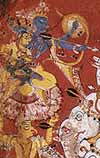 |
==The
Bhagavata Purana is completed (c.900's): "The Bhagavata
Purana...describes
the incarnations of Vishnu and draws on earlier Vaishnava traditions
such
as the "Harivamsa" (1st c.) and "Vishnu Purana" (5th c.). It is
influenced
by southern ecstatic devotional traditions. Vishnu is traditionally
associated
with ten avatars ("incarnations"); two of the most popular of these are
Rama (hero of the Ramayana and model of ideal kingship) and the
cowherd/lover
Krishna" (--Met).
Here's a modern multimedia version of the Bhagavata Purana from a
disciple
of Swami Prabhupada: *bhagavatam*.
And devotional illustrations for some of its episodes: *Black
Peacock*. |
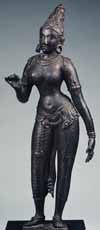 |
==The
Chola dynasty (c.860-1285) is established in the South
by
members of an ancient royal family; for the next several centuries,
their
kingdom is an important player in Indian politics. The Cholas absorb
the
Pandyas (920); but their expansion northwards is blocked by the
Hoysalas
in the Deccan--which also shields them from some of the more chaotic
northern
political developments of the next few centuries. Above all they are
famous
for the astonishing "Chola bronzes" beloved of art historians--and of
everybody
else who ever sets eyes on one. The Met considers them "among the
finest
works of art in the world." Discussion by "art and archaeology": *Chola
bronzes*; *Rajaraja
Museum pieces*. |
 |
==Abhinavagupta
(c.990-1015): "In Kashmir, philosopher Abhinavagupta expands on the
theory
of rasa, building on earlier work first articulated by Bharata in the
4th
c. in the "Natyashastra" (the Science of Dance). A basic component of
Indian
aesthetic theory, rasa ("flavor") refers to the emotional and aesthetic
experience incited by performance, poetry, and art. There are nine
types
of rasa....Experiencing the flavor of a work of art requires not only
that
the work evoke a response, but also that the experiencer possess the
aesthetic
sophistication and knowledge required to respond in an appropriate way.
The experience of a work of art is thus a process of exchange" (--Met).
Discussion: *K.
N. Dhar*; *P.
C. Hogan*. |
|
|








